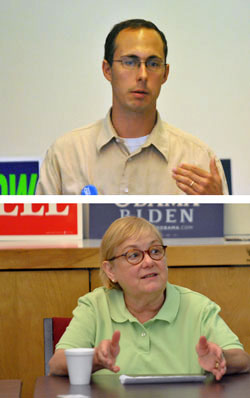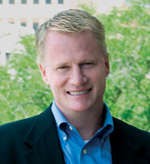A forum hosted by the Ann Arbor Democratic Party on July 14 featured eight candidates in four city council Democratic primary races. This article summarizes the responses from Ward 5 candidates Chuck Warpehoski and Vivienne Armentrout. The winner of the Aug. 7 primary will face Republican Stuart Berry in the November general election. Other races are covered in separate Chronicle articles.

Ward 5 Ann Arbor city council candidates Chuck Warpehoski and Vivienne Armentrout. (Photos by the writer.)
The Ward 5 seat will be open this year, because incumbent Carsten Hohnke chose not to seek a third two-year term on the 11-member council – which includes the mayor and two representatives from each of the city’s five wards. Democratic primaries are contested this year in just four of the five wards, as Christopher Taylor is unchallenged in Ward 3.
Hohnke was first elected to the council in 2008, winning the general election against Republican John Floyd. In the August primary that year, Hohnke won a very close race against Armentrout, who is competing for a Ward 5 seat again this year.
Armentrout said she’s running based on her experience – and her involvement in the civic life of Ann Arbor. She cited her involvement with organizations like the Ecology Center, Project Grow, and the League of Women Voters. She also cited her service on public bodies like the city’s solid waste commission, the city budget review committee, as well as the Washtenaw County board of commissioners, an elected position that she held for eight years.
After she left the board of commissioners, she worked as a journalist, she said, focusing primarily on city issues for the Ann Arbor Observer. And she’s been writing a local issues blog since 2009 – Local in Ann Arbor. She wants to apply her experience to represent the residents of Ward 5.
Warpehoski told the forum attendees that he is running because he wants to serve the community. He stressed his strong Democratic values – like environmental protection, and a commitment to a strong social safety net. In his day job as executive director of the Interfaith Council for Peace and Justice, he is already serving the community, he said, but service on the city council is another way to serve the community. He stressed the importance of the mix that Ann Arbor offers – of a vibrant downtown and great neighborhoods.
Warpehoski noted that elections end up being a discussion about candidates. But fundamentally, he said, he does not believe that public service and elected office is about the candidate – rather, it’s about the community. That’s why the center of his campaign has been knocking on doors all across Ward 5, he said. And when he approaches the door, he said he’s not starting with a commercial for himself. Instead, he begins with a question: What’s on your mind about what’s going on in the city?
The single main policy issue that candidates were asked to address was a possible new train station at the Fuller Road site – and transportation is an issue on which Armentrout and Warpehoski have the most different perspectives. But the Fuller Road Station was touched on just briefly. Armentrout listed several reasons why she’s opposed to a rail station at Fuller Road, while Warpehoski is supportive of the idea. But he indicated that if the ultimate recommendation of a current study that’s being conducted is to locate a new facility at Fuller Road, he thinks it deserves a public referendum, because it is public land.
Aside from opening and closing statements, not a lot of specific local policy ground was covered by questions put to the candidates – due in part to a time constraint of about an hour for eight candidates. But the candidates did talk a great deal about issues of transparency and group dynamics on the city council – in response to the leadoff question from forum moderator Mike Henry, co-chair (with Anne Bannister) of the Ann Arbor Democratic Party.
Responding to the question of working as a group, Warpehoski described the techniques of “deep listening,” and stressed the importance of assuming good intent. For her part, Armentrout stressed the importance of expressing mutual respect and in making decisions based on data and on the merits of the case, and “arguing politely,” whatever the case is.
Broadcast live earlier in the week on the Community Television Network was a League of Women Voters candidate forum that included Armentrout and Warpehoski, which is available online.
The deadline to register to vote in the Aug. 7 primary has passed. Oct. 9 is the last day to register to vote for the Tuesday, Nov. 6 general election. Information on voter registration can be found on the Washtenaw County clerk’s elections division website. To see a sample ballot for your precinct, visit the Secretary of State’s website. The League of Women Voters also has an online voter information site – Vote411.org – which includes biographical information on some candidates, stances on issues, and a “build my ballot” feature. [Full Story]









